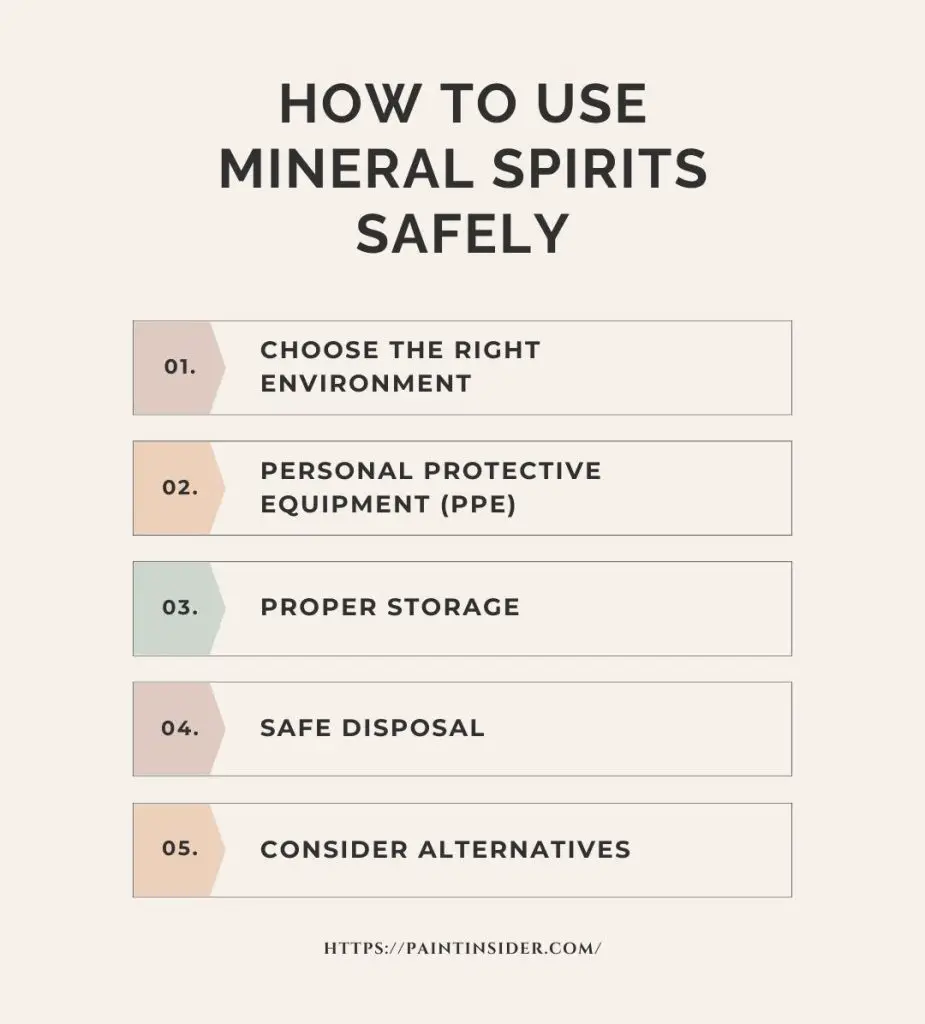Learn what mineral spirits are, how to use them safely, and explore effective alternatives. Learn about their uses in painting, cleaning, and DIY projects, along with essential safety tips to protect your health and environment
Introduction: what are mineral spirits?
Mineral spirits, often referred to as white spirits or paint thinner, are petroleum-derived solvents widely used in various applications, particularly in painting and cleaning. Their primary function is to dissolve oils and resins found in many paints and finishes, making them invaluable for artists and DIY enthusiasts alike. Unlike harsher solvents, mineral spirits offer an effective alternative that evaporates slowly, allowing for better control during painting tasks.
In addition to their role as paint thinner, mineral spirits can also be used to clean brushes and equipment after paint jobs, ensuring the longevity of tools without compromising performance. However, it’s crucial to consider safety when using these solvents; proper ventilation is necessary to avoid harmful inhalation while working with them indoors. For those seeking eco-friendly options or alternatives due to sensitivity concerns, products like vegetable oil-based wipes or even rubbing alcohol can serve as gentle substitutes without sacrificing effectiveness in various cleaning applications.
Definition of Mineral Spirits
Mineral spirits, also known as white spirits or mineral turpentine, are a clear, petroleum-derived solvent used primarily as a paint thinner and degreasing agent. They are commonly applied to thin oil-based paints, clean paintbrushes, remove sticky residues, and degrease metal and automotive parts. Known for being less toxic and lower in odor than traditional turpentine, mineral spirits are a popular choice in both industrial and DIY settings. However, they are still flammable and should be used with proper ventilation and care.
Common Uses of Mineral Spirits
Mineral spirits, a petroleum-derived solvent, play a versatile role in various applications. Here are some common uses that highlight their importance:
- Paint Thinner: Often used for thinning oil-based paints and varnishes, mineral spirits improve the flow and application of these substances, making them easier to work with.
- Cleaning Agent: They excel at removing grease, grime, and paint spills from brushes and surfaces. Artists often rely on mineral spirits to clean up their tools swiftly without causing damage.
- Stain Removal: From carpets to upholstery, mineral spirits can effectively lift stubborn stains caused by oils or paints. A little dab can work wonders when tackled promptly.
How to Use Mineral Spirits Safely
When working with mineral spirits, understanding their properties and uses is crucial for safety.

- Choose the Right Environment: Always use mineral spirits in a well-ventilated area to minimize inhalation risks. Open windows and doors, or work outdoors if conditions permit. Your comfort and health should be priorities; this simple step can make a significant difference.
- Personal Protective Equipment (PPE): Equip yourself with appropriate PPE such as gloves and goggles. This barrier not only shields your skin from irritation but also protects your eyes from splashes that might harm them.
- Proper Storage: Store mineral spirits in a cool, dry place away from flame sources, as they are flammable. Ensure that the container is tightly sealed to prevent evaporation and accidental spills keeping it out of reach of children is equally essential.
- Safe Disposal: When finished using mineral spirits, never pour them down the drain or throw them in regular trash, instead, take leftover substances to hazardous waste facilities for safe disposal. This practice helps protect local waterways and ecosystems.
- Consider Alternatives: For those wary of chemical solvents, look into alternatives like citrus-based cleaners or vinegar solutions which can often serve similar purposes with lower health risks. Stepping away from traditional options can nurture both safety and environmental concerns without sacrificing effectiveness.
Health Risks and Precautions to Consider
When using mineral spirits, it’s crucial to recognize the potential health risks associated with exposure. Prolonged inhalation of vapors can lead to respiratory issues, dizziness, or neurological effects. Individuals with pre-existing respiratory conditions may find their symptoms exacerbated in poorly ventilated areas. To mitigate these risks, it’s advisable to use mineral spirits outdoors or in well-ventilated spaces while wearing appropriate personal protective equipment such as masks and gloves.
Environmentally Friendly Alternatives
Here are some environmentally friendly alternatives to mineral spirits that can work effectively for cleaning, degreasing, and thinning without the same environmental impact:
- Citrus-Based Solvents: Derived from citrus peels, these biodegradable cleaners are effective for removing grease, adhesive, and some types of paint. They have a pleasant smell and are generally safe for both the environment and indoor use.
- Soy-Based Solvents: Made from soybean oil, these solvents are low in volatile organic compounds (VOCs) and are biodegradable. They work well for cleaning tools, degreasing, and some paint-thinning applications.
- Rubbing Alcohol: For small cleaning tasks, isopropyl alcohol is a good option. It evaporates quickly, leaves no residue, and can be used as a degreaser in certain situations, though it may not be suitable for all paint types.
- Olive Oil or Vegetable Oil: For simple cleaning tasks, especially of oil-based paints, vegetable oils can help remove paint from skin or tools. Follow with soap and water to wash away residues.
- Water-Based Degreasers and Cleaners: For general cleaning and degreasing, water-based solutions are a safe, non-toxic alternative that produces little environmental impact. Look for products labeled as biodegradable or eco-friendly.
- Acetone (with Caution): While acetone is more eco-friendly than mineral spirits and biodegrades faster, it should still be used with care as it is flammable and can be an irritant. Acetone works well for some cleaning tasks and removing adhesives.
- Turpentine Alternatives: Eco-friendly versions of turpentine are available, often made with natural oils or biodegradable ingredients, making them a greener substitute for mineral spirits in paint thinning.
Each alternative may have specific use cases, so consider the project’s needs when selecting an environmentally friendly option.
Tips for Proper Storage and Disposal
When it comes to storing mineral spirits, it’s crucial to prioritize safety. Always keep the container tightly sealed and stored in a cool, dry place away from direct sunlight and sources of heat. This not only preserves the integrity of the mineral spirits but also reduces fire risks associated with volatile substances. Consider using labeled containers that identify their contents; this helps prevent accidental misuse or spills.
When disposal becomes necessary, avoid pouring mineral spirits down drains or toilets this can lead to environmental hazards. Instead, check for local hazardous waste collection events or facilities where you can safely drop off unwanted products. If disposal options are limited in your area, another solution is to let any leftover mineral spirits evaporate in a well-ventilated space before disposing of the empty container. Prioritizing proper storage and responsible disposal protects both your home environment and the planet, showcasing a commitment to sustainable practices even when working with potentially harmful substances like mineral spirits.
FAQs About Mineral Spirits
1. What are mineral spirits?
Mineral spirits are a clear, colorless liquid made from petroleum, commonly used as a solvent in paint thinners and cleaners.
2. What are the main uses of mineral spirits?
They are primarily used for thinning oil-based paints, cleaning brushes, removing paint stains, and degreasing surfaces.
3. Are mineral spirits safe to use indoors?
While they can be used indoors, it’s essential to ensure proper ventilation since the fumes can be harmful if inhaled.
4. How should I store mineral spirits?
Store them in a cool, dry place away from heat sources and out of reach of children and pets in a tightly sealed container.
5. Can I use mineral spirits on all types of surfaces?
Mineral spirits work well on many surfaces but can damage some plastics or varnished finishes; always test a small area first.
6. What alternatives exist for mineral spirits?
Alternatives include denatured alcohol, acetone, or citrus-based solvents which can also be effective for cleaning and thinning paints.
7. How do I dispose of leftover mineral spirits?
Dispose of them according to local hazardous waste guidelines; never pour them down the drain or throw them in regular trash.
8. Can I use mineral spirits to clean my hands after painting?
Yes, you can use mineral spirits to remove paint from your hands, but it’s best to follow up with soap and water for skin safety.
Conclusion: Understanding Mineral Spirits and Their Use
In summary, mineral spirits are more than just a solvent. They serve as an indispensable tool for DIY enthusiasts, artists, and professionals alike. Their ability to effectively dissolve oils and clean brushes highlights their versatility, making them a top choice for various applications. However, understanding their uses goes hand in hand with acknowledging the safety considerations involved. Proper ventilation and protective gear are essential safeguards when working with these compounds to mitigate any health risks.
Moreover, while mineral spirits have long been favored in many circles, exploring alternatives can lead to even more environmentally conscious choices. Options such as citrus-based solvents or bio-based cleaners provide effective cleaning without the chemical drawbacks associated with traditional mineral spirits. By broadening our horizons towards safer alternatives while maintaining effectiveness in our projects, we empower ourselves to create responsibly and sustainably keeping both our workspaces tidy and our planet healthier.

